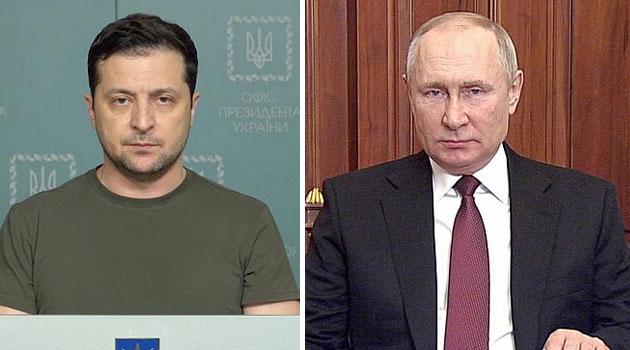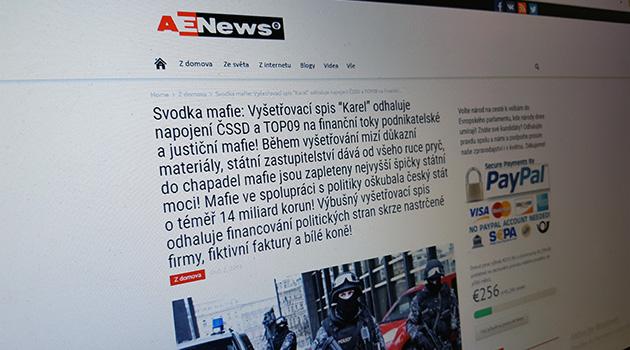Pro-Kremlin fakery and manipulation: What to make of Russian claims of Ukraine's alleged "genocide", Fascism and Nazism?

Massive sharing of pro-Kremlin disinformation and manipulative allegations is accompanying the ongoing attack by the Russian Army on Ukraine, and as news server Romea.cz has previously reported, CZ.NIC, the Czech Republic’s domestic Internet association, blocked eight disinformation sites last week after consulting with the security services and at the recommendation of the Government. However, manipulative narratives that are pro-Kremlin continue to spread online in the Czech language anyway.
The company Semantic Visions noted the initial uptick in the activity of such online trolls in November 2021, when the presence and rising numbers of Russian troops along the borders of Ukraine began to be more and more discussed. Let’s take a look at the most frequently-shared manipulations about the Russian occupation of Ukraine.
ALLEGATION: “The EU, NATO, UKRAINE and USA bear responsibility for the conflict escalating”
This lie runs through all posts by pro-Kremlin trolls. The fact is that representatives of the EU, NATO, Ukraine and USA have been doing their best for months, using diplomatic means, to deter Russia from accelerating its invasion. In the meantime, however, President Putin accumulated more and more soldiers and military equipment on the borders of Ukraine.
ALLEGATION: “Russian is just defending itself against aggression from Ukraine and stopping a genocide against the Russian residents in eastern Ukraine”
This is another lie that frequently surfaces and is constantly repeated. The Kremlin has long alleged that the Government of Ukraine is “persecuting” ethnic Russians and Russian-speaking citizens. These accusations claim to be “supported” by untrue stories about anti-Russian violence, and in 2014 they served to justify Russia’s annexation of the Crimean peninsula and subsequent occupation of eastern Ukraine by pro-Russian separatists. Putin is using rhetoric similar to that used by Adolf Hitler before occupying the Sudetenland in 1938 in what was then Czechoslovakia.
There is no evidence of any “genocide” being planned or perpetrated against Russian residents of Ukraine. Videos purporting to prove such allegations have been faked.
In reality, Moscow has long supported pro-Russian separatists in eastern Ukraine, who have provoked exchanges of gunfire with the Army of Ukraine so that Moscow could use such incidents as a pretext for its invasion.
ALLEGATION: “Ukraine is a Fascist, Nazi state”
“Cleansing Ukraine of Nazis” is one of the slogans President Putin used when beginning his occupation of Ukraine. This lie is quite frequently repeated in different online discussions, including among Romani users of the Czech-language Interent, and as “evidence”, these people attach photographs purporting to show Ukrainian President Volodymyr Zelenskyy giving the Nazi salute.
One photograph that is meant to document this use of the Nazi salute dates from 28 April 2021, when about 100 neo-Nazis did actually assemble in Kyiv. However, the man in the photograph is not Zelenskyy, but a person named Volodymyr Koshovenko. Another such photograph dates from 2014, when Zelenskyy was still just working as a much-loved actor in the film industry and performed in a comedy sketch parodying the narratives being spread about Ukraine.
What is true is that Ukraine has been grappling with right-wing extremists who, for example, have assaulted Romani people or who joined the “Azov Battalion“, and that the “Right Sector” group has been in operation there. News server Romea.cz has regularly reported on this phenomenon. The official representatives of Ukraine have, since 2014, clearly spoken out against such radical groups, and the Interior Ministry of Ukraine ordered the disarmament of all such radical groups in 2014.
One leader of “Right Sector” was labeled a gangster by the authorities in Ukraine and was shot dead when police in Ukraine apprehended him.
Other countries have similar problems. Let’s recall, for example, the Czech Republic, where from 2008-2013, regular, racist, anti-Roma protests were held. They were organized by the “Workers’ Party” led by Tomáš Vandas, which was dissolved by the courts in 2010, and it is no accident that it is exactly Vandas who today is standing on Russia’s side. Paradoxically, nothing stopped him from inviting neo-Nazi representatives from the “Right Sector” to the Czech Republic in 2014.
The Czech Army also faced a scandal in 2009 when journalists published photographs of two commanders from the elite Fourth Rapid Deployment Brigade who had just returned from Afghanistan and who had been wearing the coats of arms of Nazi divisions and SS brigades on their helmets during their entire tour of Logar.
Excesses committed by individuals cannot be interpreted as the policy of an entire state, though.
As Zola Kondur, a Romani activist from Ukraine, says in an interview for Romanoforum.sk, the Government of Ukraine is democratic and cooperates with Parliament and with local and national authorities. It does its best to be democratic and transparent and to cooperate with national minorities, Romani people included.
“For example, two years ago, a special authority was established to design Government policy about different ethnic groups. It is meant to respond to the needs of national minorities and Romani people in Ukraine. Parliament has also been working on a new law that is meant to protect their rights. We have a National Romani Strategy that was approved in July 2021 to ensure inclusion measures. A great deal has been done for the civic and political participation of national minorities at the local and national level too,” Kondur said in the interview.
On top of all this, Romani people have joined the battles underway now and are in the Army of Ukraine.
ALLEGATION: “Historically, Ukraine is Russian territory”
The Kremlin frequently references Kievan Rus’ as the first Russian state. In reality, however, Kyiv was established by the Rurik dynasty of the Vikings. During a subsequent historical phase the Mongols controlled the territory of what is today Ukraine (or better said, a large part of it), and after them, the Lithuanian-Polish constellation called the Rzeczpospolita.
The area currently known as Luhansk was created in 1795, when a British industrialist, Charles Gascoigne, established a factory there for metals near the settlement of Kamianyi Brid, which itself had been established by Cossacks from Zaporozhye. The settlement around the factory became known as the “Luganskiy Zavod” (Luhansk Factory).
In 1869, John Hughes, a Welsh businessman, established a coalmine and steel mill in what is today Donetsk, and that city was named after him – Hughesivka or Yuzivka.
Neither the eastern region of Ukraine, nor Ukraine as a whole today, had any historical link to the Russian Federation or its predecessor states until the late 18th century, when its territory was forcibly, gradually annexed to Imperial Russia. The centuries to follow involved forced Russification, pressure from the Russians and attempts by the Ukrainians to create their own independent state.
Today Ukraine is an officially recognized state within its existing de jure borders. In 2003, Russia and Ukraine mutually recognized their borders territorially at the level of their presidencies, and in 2004 that agreement was ratified by their national Parliaments.
As far as Crimea is concerned, Imperial Russia annexed it to its territory in the late 18th century (just like other territories of what is today Ukraine) and began to intentionally relocate population from Russia there. After the First World War and the Bolshevik Revolution, an autonomous Crimean Soviet Republic was established there in 1921. During the ethnic cleansings that were perpetrated by Soviet leader Stalin there, the Crimean Tatars suffered intensively, as did the community of Greeks. In 1954, Soviet leader Nikita Khruschev gave Crimea to Ukraine.
